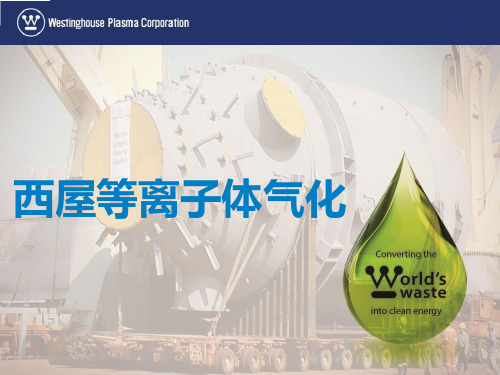美国工程院院士Miles关于等离子体流动控制的PPT
等离子体流动控制

等离子体流动控制等离子体流动控制是一项重要的科学研究领域,涉及到等离子体物理学、流体力学、控制理论等多个学科。
等离子体是一种带电粒子和中性粒子组成的高温、高电离状态的物质,广泛存在于自然界中的太阳、恒星和闪电等现象中,也可以通过人工的方法产生。
等离子体流动控制的研究旨在利用外部的力和能量来操控等离子体的流动,以达到调控等离子体性质和行为的目的。
等离子体流动控制的研究和应用有着广泛的领域,包括等离子体加速、等离子体推进、等离子体喷射、等离子体混合等方面。
其中,等离子体加速是指通过施加电场、磁场或电磁波等力来加速等离子体粒子,使其获得更高的动能。
这在核聚变实验中是一项关键的技术,通过控制等离子体流动,可以提高核聚变反应的效率,并减少能量损失。
等离子体推进技术是航天领域的热门研究方向之一。
通过控制等离子体的流动,可以产生推力,从而实现航天器的姿态调整、轨道修正和推进等任务。
相比传统的化学推进技术,等离子体推进技术具有推力大、比冲高、燃料效率高等优点,被认为是未来航天技术的重要发展方向。
等离子体流动控制还可以应用于等离子体喷射和等离子体混合等领域。
等离子体喷射是指通过控制等离子体的流动,使其喷射到目标物体上,从而实现材料表面的改性、涂层的制备等功能。
等离子体混合是指将两个或多个等离子体进行控制性的混合,从而实现化学反应、能量传递等目的。
在等离子体流动控制的研究中,常用的手段包括电磁场控制、热力学控制和流体力学控制等。
电磁场控制是通过施加外部的电场、磁场或电磁波等力来操控等离子体的运动和行为。
热力学控制是通过控制等离子体的温度、压力和浓度等参数来调节等离子体的性质和行为。
流体力学控制是通过改变等离子体的流动方式和流动速度等来实现对等离子体流动的控制。
为了实现等离子体流动控制,研究人员通常采用数值模拟、实验研究和理论分析等方法。
数值模拟是利用计算机对等离子体流动进行数值模拟和计算,以预测和优化等离子体流动的行为。
等离子体基本概念.ppt

17
电子等离子体振荡频率 :
pe n0e2 / me0
pe 与等离子体的密度、电子质量、电荷
有关,
pe 等离子体的特征频率 振荡周期 1/ pe
等离子体准电中性的特征时间。
2019-10-31
感谢你的聆听
18
离子等离子体振荡
如果出现离子的电荷涨落,它在静电力的作用下 也会向其原来的电中性平衡位置运动,产生离子 等离子体振荡或简称离子振荡。
2019-10-31
感谢你的聆听
3
等离子体物理的影响与作用
认识和掌握各种条件下等离子体运动规律是人类 认识宇宙中各种现象的基本前提。 等离子体物理是提供太阳、恒星、行星际介质和 银河系知识的基石之一。
等离子体物理研究为人类解决能源问题带来希望。 因为实现核聚变能利用,需改善约束和加热等离 子体的方法。因此,掌握高温等离子体的运动规 律是实现受控核聚变的关键。
2019-10-31
感谢你的聆听
27
等离子体定义(统一的 )
必须指出,并非任何带电粒子组成的体系 都是等离子体,只有具备了等离子体特性 的带电粒子体系,才可称为等离子体。
电子等离子体振荡特征时间:
pe 1/ pe
作为等离子体宏观时间尺度。 因为 p,e 电子等离子体振荡总是存在; 仅当 pe ,空间电荷、空间电场等的时间 平均都为0,因此,电子等离子体振荡特征 时间是衡量等离子体准电中性的时间下限。
2019-10-31
感谢你的聆听
等离子体广泛存在于宇宙空间(从电离层到宇宙深 处的可见物质几乎都是电离状态),宇宙空间的可 见物质99%是等离子体。地球表面几乎没有自然存 在的等离子体。只有闪电、气体放电等实验室中出 现的电离气体,即等离子体。
《等离子体表面处理》课件

导电性能
通过四探针测试仪或Hall效应测试仪测量表面的导电性能, 评估等离子体处理对表面电学性能的影响。
PART 05
等离子体表面处理的优势 与局限性
等离子体表面处理的优势
01
02
03
04
高效性
等离子体表面处理技术能够在 短时间内对大面积的表面进行
总结词
等离子体是由部分或全部原子或分子处于激发态的电离气体,其整体呈中性。
详细描述
等离子体是由气体在足够高的电场或温度下被完全或部分电离,形成由带正电 的离子和带负电的电子组成的电离气体。在宏观上,这些带电粒子的净电荷为 零,因此等离子体整体呈中性。
等离子体表面处理技术的原理
总结词
等离子体表面处理技术利用等离子体的物理和化学性质,对材料表面进行激活、刻蚀、 沉积等处理。
通过引入智能化技术,实现等离子体 表面处理的自动化和智能化。
绿色环保
未来的等离子体表面处理技术将更加 注重环保和可持续发展。
新材料应用
随着新材料的不断涌现,等离子体表 面处理技术将在新材料领域得到更广 泛的应用。
处理,提高了生产效率。
环保性
等离子体表面处理技术不使用 化学试剂,减少了环境污染。
均匀性
等离子体能够均匀地覆盖处理 表面,保证了处理效果的均匀
性。
适用性广
等离子体表面处理技术适用于 各种材料和表面的处理。
等离子体表面处理的局限性
设备成本高
等离子体表面处理设备成本较 高,增加了生产成本。
处理厚度有限
等离子体表面处理工艺流程
预处理
清除工件表面的污垢和杂 质,保证处理效果。
等离子体基本原理优秀课件

blue
Positive Column
Red-pink red-brown dark-red blue-purple
whitegreen pink red-yellow red-yellow red-yellow
7
介质阻挡放电(DBD)
8
滑动电弧放电等离子体
9
激光
密度(cm-3)
17
地球上,人造的等离子体也越来越多地出现在我们的周围。 日常生活中:日光灯、电弧、等离子体显示屏、臭氧发 生器 典型的工业应用:等离子体刻蚀、镀膜、表面改性、喷 涂、烧结、冶炼、加热、有害物处理 高技术应用:托卡马克、惯性约束聚变、氢弹、高功率 微波器件、离子源、强流束、飞行器鞘套与尾迹
12
空间天体等离子体 什么保护了地球:等离子体
13
空间天体等离子体
北极光
14
空间天逃体离等太离阳子体的等离子体
15
空间天星体系等:离巨子体大的聚变反应堆
16
等离子体参数空间
温度 (度)
星云
太阳风 星际空间
日冕
霓虹灯 荧光
磁约束 聚变
氢弹
惯性聚变
太阳核心 闪电
气体 液体 固体
北极光
火焰
人类居住环境
+
-
在等离子体内部,正、负电荷数几乎相等——准中性 ne ni
30
就等离子体本身而言,它具有变成为电中性的强烈 倾向,故离子和电子的电荷密度几乎相等,此种情况称 为准中性,是带相反电荷粒子间的强电作用的结果。
等离子体中电荷分离仅可能由外加电场或等离子体 本身的内能(热能)来维持,可由等离子体动力学温度 维持的对电中性的最大偏离估算出来。
等离子体物理基础-复习PPT课件

q q m u 2
第一章 绪论
-库仑碰撞 b 0 180
b b0 b b0 b b0
90 90 90
近碰撞 远碰撞
lL b0
q q m u 2
q q m u 2
q q kT
q q / d kT nl3L 1
lL / d 1 等离子体中库仑近碰撞不重要
lL d lD l 90
Thank You
在别人的演说中思考,在自己的故事里成长
Thinking In Other People‘S Speeches,Growing Up In Your Own Story
讲师:XXXXXX XX年XX月XX日
l 90
1
n l2L
-经典条件
d
mekT
第二章 单粒子理论
✓ 拉莫尔运动
等离子体具有抗磁性
第二章 单粒子理论
✓ 电漂移
vE cE B / B2
| E || B |
与带电粒子性质无关,对所有粒子都相同。
第二章 单粒子理论
✓ 极化漂移
vp
mi c 2 qi B02
dE dt
-与带电粒子性质有关,与质量成正比,漂移方向与粒子 电荷符号有关,电子和离子方向相反,产生一个极化电 流。
c2
vi
cE B0 B02
i
mi c 2 qi B02
E
ve
cE B0 B02
极化漂移, 与质量成正比
第四章 等离子体中的波
1、电磁波
2
2 p
c2k2
✓ 折射率
n2
k 2c2
2
1
2 pe
2
1 ne nc
✓ 临界密度
等离子体技术与应用英文课件:Lecture 01-Introduction

5. 等离子体化学与工艺,赵化侨 编著,中国科学技术大学出版社, 合肥,中国,1993年。
Plasma Lectures 6
Topic 1: Introduction:概论
1. What is PLASMA?什么是等离子体? 2. What is LOW TEMPERATURE PLASMA?什么是低
- I will give a brief introduction to each part, then ask you to search,collect and read references based on your interesting relevant to the topics, write course report (Homework) and give a presentation for class discussion. 对每个专题,教师先讲 解;要求同学根据自己的兴趣进行资料收集及阅读,撰写报 告及课件(作业),进行课堂讨论。
相关薄膜沉积及表面改性-1 -Topic 13: Overview of Plasma related thin film deposition and surface modification 等离子体技术
相关薄膜沉积及表面改性-2 -Topic 14: Sputtering Deposition-1 -Topic 15: Sputtering Deposition-2 -Topic 16: Ion Implantation 离子注入-1 -Topic 17: Ion Implantation 离子注入-2 -Topic 18: Ion Implantation 离子注入-2 -Topic 19: Plasma Enhanced Chemical Vapor Deposition (PECVD) 等离子体增强化学气相沉积 -Topic 20: Plasma Technology Applications in Solar Cell Fabrication 等离子体技术在太阳能电池制备中
等离子体气化技术PPT课件

示范项目, 中国上海
• 该工厂可以满足巴巴多斯25%的 电力 需求,以及显著减少能源的费用
“Cahill Energy为我们提供了成为能源独立的一个真正的解决方案,而在同一时间减少了 我们大量的石油进口账单。Cahill Energy带来的废物能源化技术远远优于其他任何我们 已经研究过的技术。我们相信我们的国家将永远因此而改变。”
5
中国垃圾的经济价值
“2025年以前垃圾的产生增长为 69% ”.
世界银行数据
2012年 市场总值
垃圾 520,000 tonnes/day
液体燃料 400,000 Bbls/day
(或)
合成气 1,780,000,000 Mmbtu/year
(或)
电力 26 GW capacity
Source: World Bank
我们是谁?
Alter NRG 是一家在多伦多上市交易的提供清洁能源方案的可替代能源公司。 (TSX: NRG; OTCQX: ANRGF).
我们的愿景 为了一个健康的地球而为全球客户提供废物转化为清洁能源领先的技术平台。
我们的使命 作为行业领导者,通过部署在世界各地的多个项目,我们已经占据了革新目前废物管理的 领域。我们通过向客户提供等离子气化设备,服务和解决方案,来创新和环保地将废物转 化为清洁能源,从而创造股东价值。
PPT-等离子体理论

本书给出的是最主要的两类描述法:
两种方法的区别: 动理学方法和流体力学方法都是研究多 粒子体系物理性质的理论工具,但动理 学方法和流体力学的三维空间描述不同, 它通常是在六维的坐标-速度空间来描 述等离子体,而且还可以扩展到 6N(n=1.2…)维空间作描述。之所以需 要用速度空间来描述,是因为有些多粒 子体系的行为和它们粒子的速度状态有 密切关系,因此仅仅在坐标空间作描述 就不够了。
等离子体理论基础
等离子体是由处在非束缚态的带 电粒子组成的多粒子体系。它和 气体、液体、固体一起构成了自 然界物质在同一层次上的四大基 本形态。 等离子体属于多粒子体系,因此 以往对中性多粒子体系发展出的 各种描述方法对它也适用,只是 要作相应的改造和发展。
本书中介绍的是对所谓的“理想、经 典等离子体”的理论描述方法。这时 粒子的平均动能大于平均(库伦) 势能,而粒子的运动服从牛顿力学 规律。 本书从第一章开始,就由繁至简地 介绍了描述“理想经典等离子体”的 各种理论方法。本书的描述对象主 要是高温、完全电离的等离子体。
• 输运
• 波驱动电流 • 碰撞积分的数学理论—BBGKY途径简介
完ห้องสมุดไป่ตู้
第三部分 弗拉索夫波动理论
• 和粒子有相互作用的波的物理特点及数学描述
• 无外场、空间均匀、速度空间各向同性等离子体
的线性弗拉索夫方程解
• 均匀外磁场、空间均匀情况下的本征值问题
• 空间不均匀、外磁场均匀情况下的漂移波
• 静电不稳定性
• 湍动过程简介
第四部分 碰撞和输运
• 碰撞和输运引论
• 碰撞算子
第一部分 磁流体力学
• 磁流体力学方程组及其基本性质
• 磁流体力学平衡
• 磁流体力学波
- 1、下载文档前请自行甄别文档内容的完整性,平台不提供额外的编辑、内容补充、找答案等附加服务。
- 2、"仅部分预览"的文档,不可在线预览部分如存在完整性等问题,可反馈申请退款(可完整预览的文档不适用该条件!)。
- 3、如文档侵犯您的权益,请联系客服反馈,我们会尽快为您处理(人工客服工作时间:9:00-18:30)。
Positive pulses Negative bias Surface potential, mm
2.0
Surface potential, V
1.5
1 pulse 10 pulses 100 pulses 1000 pulses
-1.0
1 pulse 10 pulses 100 pulses 1000 pulses
Main differences between pulses with arbitrary bias and sine voltage
Sine Voltage Pulses with Bias
Two functions simultaneously: Plasma generation and body force on the gas
Schlieren technique, burst mode of plasma actuator operation, and 2-D fluid numerical model coupled together allow to restore the entire twodimensional unsteady plasma induced flow pattern as well as the characteristics of the plasma induced force.
Predicted Momentum Transfer with 4 nsec pulses
Blue and green lines correspond to the negative pulses with amplitudes -4.5 and 1.5 kV with positive bias of 0.5 kV, and the pink line corresponds to the positive pulses with 3 kV amplitude and positive bias of 1 kV. FWHM for all pulses is 4 ns.
Results
DC Bias experiments
Pulses: 50 kHz - 20 µs between pulses 500 pulses per burst - 10 ms per burst 1000 pulses per period - 50 bursts per second
5kV pulse voltage -2 kV.. +2 kV DC bias voltage
Offset DBD Configuration for Flow Control
Surface Plasma
Limitations of Sinusoidal Driven DBD Control
Breakdown occurs randomly during each cycle There is a significant backward component of the thrust during the cycle Thrust is not generated equally in the positive and negative portion of the cycle The duty cycle is low – part of the time no thrust is being generated
Positive pulses
2.5 2.0 Positive bias Zero bias Negative bias
Negative pulses
2.0 1.5
Positive bias Zero bias Negative bias
Surface potential, kV
Surface potential, kV
1.0
-0.5
0.5
0.0 -5 0 5 10 15 20
0.0
-5 0 5 10 15 20
Distance, mm
Distance, mm
2.0
Negative pulses Positive bias
Surface potential, V
Predicted Streamer Like Ionization with 3kV, 4 nsec positive pulses and 1 kV positive DC bias
Predicted Average Force with 3kV, 500kHz, 4 nsec positive pulses and 1 kV positive DC bias
Pulse Sustained, DC Driven DBD Concept
Dielectric material: kapton tape thickness 100 µm Electrodes: copper foil width 25 mm spanwise dim. 50 mm
The circuit is designed so as to superimpose short pulses on a low frequency bias voltage without interference between the pulser and the low-frequency power supply. The pulses and the bias voltage are controlled independently
Momentum, transfered to the gas
1.4E-08 1.2E-08 Momentum, N*s/m 1.0E-08 8.0E-09 6.0E-09 4.0E-09 2.0E-09 0.0E+00 0.0E+00 4.0E-07 8.0E-07 1.2E-06 1.6E-06 2.0E-06 Time, s High-V neg. pulse High-V pos. pulse Low-V neg. pulse
1600 1400 1200
Surface potential, V
1000 800 600 400 200 0 -200 -2 0 2 4 6 8 10 12 14 16 18 20 22 24 26 28
Distance, mm
Surface Charge Build up with 2kV DC bias and 4kV pulses at 20 kHz
1.5 1.0 0.5 0.0 -0.5 -1.0 -1.5 0 5 10 15 20 25
1.0 0.5 0.0 -0.5 -1.0 -1.5 -2.0 0 5 10 15 20 25
Distance, mm
Distance, mm
Charge Build-up Rate BuildPositive pulses Positive bias
Terminology
Terminology used in the paper for the pulse and bias voltage polarities. The encapsulated electrode is always considered to be at zero potential. The sign of potential of the exposed electrode relative to the encapsulated one determines the pulse and bias polarity.
Pulses efficiently generate plasma
Bias produces the body force on the gas
The parameters of pulse-bias configuration – peak pulse voltage, pulse repetition rate, pulse burst rate, duty cycle, and both the frequency and amplitude of the time-depended bias voltage – can be varied independently, greatly increasing flexibility of control and optimization of the DBD actuator
Results
Surface charge experiments Positive pulses
0 kV Bias Voltage +2 kV Bias Voltage 10 s 10 s
20 s
20 s
60 s
60 s
wiped
wiped
First run
0 kV → +2 kV
Results
Predicted Surface Jet Generated Vortex with pulse burst
Schlieren technique
for the DBD plasma actuator induced flow
x
0.5 m/sec at 17 mm 7 m/sec in the plasma region!
NONNON-THERMAL ATMOSPHERIC PRESSURE PLASMAS FOR AERONAUTIC APPLICATIONS Richard B. Miles, Dmitry Opaits, Mikhail N. Shneider, Sohail H. Zaidi - Princeton Sergey macheret – Lockheed Alexander Likhanskii – Penn State U.
Charge Build-up Along Surface Buildwith Sinusoidal Applied Voltage 3kHz, 10kV peak-to-peak. peak-toNon-contacting Trek Model 247-3 Electrostatic Voltmeter with Trek Model 6000B-13C Electrostatic Voltmeter Probe. • Fast response time (less then 3 ms for a 1kV step) • Operating range from 0 to +/- 3 kV DC or peak AC. • Spatial resolution of ~1 mm.
